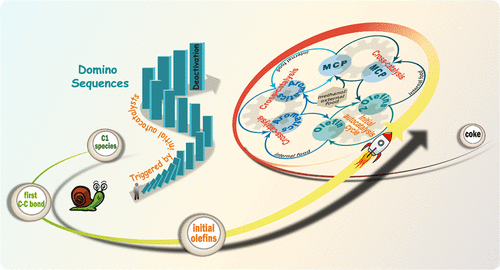当前位置:
X-MOL 学术
›
J. Am. Chem. Soc.
›
论文详情
Our official English website, www.x-mol.net, welcomes your
feedback! (Note: you will need to create a separate account there.)
Molecular Routes of Dynamic Autocatalysis for Methanol-to-Hydrocarbons Reaction
Journal of the American Chemical Society ( IF 14.4 ) Pub Date : 2021-07-28 , DOI: 10.1021/jacs.1c03475 Shanfan Lin 1, 2 , Yuchun Zhi 1 , Wei Chen 3 , Huan Li 2, 4 , Wenna Zhang 1 , Caiyi Lou 1, 2 , Xinqiang Wu 1 , Shu Zeng 1, 2 , Shutao Xu 1 , Jianping Xiao 2, 4 , Anmin Zheng 3 , Yingxu Wei 1 , Zhongmin Liu 1, 2, 4
Journal of the American Chemical Society ( IF 14.4 ) Pub Date : 2021-07-28 , DOI: 10.1021/jacs.1c03475 Shanfan Lin 1, 2 , Yuchun Zhi 1 , Wei Chen 3 , Huan Li 2, 4 , Wenna Zhang 1 , Caiyi Lou 1, 2 , Xinqiang Wu 1 , Shu Zeng 1, 2 , Shutao Xu 1 , Jianping Xiao 2, 4 , Anmin Zheng 3 , Yingxu Wei 1 , Zhongmin Liu 1, 2, 4
Affiliation

|
The industrially important methanol-to-hydrocarbons (MTH) reaction is driven and sustained by autocatalysis in a dynamic and complex manner. Hitherto, the entire molecular routes and chemical nature of the autocatalytic network have not been well understood. Herein, with a multitechnique approach and multiscale analysis, we have obtained a full theoretical picture of the domino cascade of autocatalytic reaction network taking place on HZSM-5 zeolite. The autocatalytic reaction is demonstrated to be plausibly initiated by reacting dimethyl ether (DME) with the surface methoxy species (SMS) to generate the initial olefins, as evidenced by combining the kinetic analysis, in situ DRIFT spectroscopy, 2D 13C–13C MAS NMR, electronic states, and projected density of state (PDOS) analysis. This process is operando tracked and visualized at the picosecond time scale by advanced ab initio molecular dynamics (AIMD) simulations. The initial olefins ignite autocatalysis by building the first autocatalytic cycle—olefins-based cycle—followed by the speciation of methylcyclopentenyl (MCP) and aromatic cyclic active species. In doing so, the active sites accomplish the dynamic evolution from proton acid sites to supramolecular active centers that are experimentally identified with an ever-evolving and fluid feature. The olefins-guided and cyclic-species-guided catalytic cycles are interdependently linked to forge a previously unidentified hypercycle, being composed of one “selfish” autocatalytic cycle (i.e., olefins-based cycle with lighter olefins as autocatalysts for catalyzing the formation of olefins) and three cross-catalysis cycles (with olefinic, MCP, and aromatic species as autocatalysts for catalyzing each other’s formation). The unraveled dynamic autocatalytic cycles/network would facilitate the catalyst design and process control for MTH technology.
中文翻译:

甲醇制烃反应动态自催化的分子途径
工业上重要的甲醇制烃 (MTH) 反应是由自动催化以动态和复杂的方式驱动和维持的。迄今为止,自催化网络的整个分子路线和化学性质还没有被很好地理解。在此,通过多技术方法和多尺度分析,我们获得了发生在 HZSM-5 沸石上的自催化反应网络多米诺级联的完整理论图。结合动力学分析、原位DRIFT 光谱、2D 13 C– 13C MAS NMR、电子状态和投影状态密度 (PDOS) 分析。这个过程由高级从头开始在皮秒时间尺度上进行操作跟踪和可视化分子动力学 (AIMD) 模拟。最初的烯烃通过建立第一个自催化循环——基于烯烃的循环——然后是甲基环戊烯基 (MCP) 和芳香环活性物质的形态来点燃自催化。在这样做时,活性位点完成了从质子酸位点到超分子活性中心的动态演化,这些活性中心在实验上具有不断发展的流动特征。烯烃引导和环物种引导的催化循环相互关联,形成了一个以前未知的超循环,由一个“自私”自催化循环组成(即,以较轻的烯烃作为自催化剂催化烯烃形成的烯烃循环)和三个交叉催化循环(用烯烃、MCP 和芳烃作为自催化剂催化彼此的形成)。
更新日期:2021-08-11
中文翻译:

甲醇制烃反应动态自催化的分子途径
工业上重要的甲醇制烃 (MTH) 反应是由自动催化以动态和复杂的方式驱动和维持的。迄今为止,自催化网络的整个分子路线和化学性质还没有被很好地理解。在此,通过多技术方法和多尺度分析,我们获得了发生在 HZSM-5 沸石上的自催化反应网络多米诺级联的完整理论图。结合动力学分析、原位DRIFT 光谱、2D 13 C– 13C MAS NMR、电子状态和投影状态密度 (PDOS) 分析。这个过程由高级从头开始在皮秒时间尺度上进行操作跟踪和可视化分子动力学 (AIMD) 模拟。最初的烯烃通过建立第一个自催化循环——基于烯烃的循环——然后是甲基环戊烯基 (MCP) 和芳香环活性物质的形态来点燃自催化。在这样做时,活性位点完成了从质子酸位点到超分子活性中心的动态演化,这些活性中心在实验上具有不断发展的流动特征。烯烃引导和环物种引导的催化循环相互关联,形成了一个以前未知的超循环,由一个“自私”自催化循环组成(即,以较轻的烯烃作为自催化剂催化烯烃形成的烯烃循环)和三个交叉催化循环(用烯烃、MCP 和芳烃作为自催化剂催化彼此的形成)。















































 京公网安备 11010802027423号
京公网安备 11010802027423号